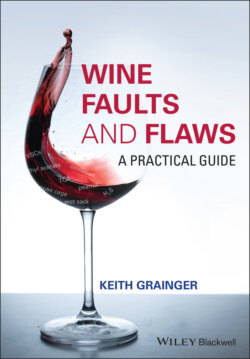Читать книгу Wine Faults and Flaws - Keith Grainger - Страница 85
2.7.11 Finish – Length
ОглавлениеPut simply, the length of the finish and aftertaste is the best indicator of wine quality. The terms ‘finish’, ‘aftertaste’, and ‘length’ sometimes give rise to confusion. ‘Finish’ refers to the final taste sensations of the wine as it is swallowed or spat. ‘Aftertaste’ encompasses the sensations that remain and develop as we breathe out, whilst ‘length’ is the measure of time for which finish and aftertaste last. To determine length, after the taster has spat the wine, they should breathe out slowly, concentrate on the sensations observing any changes or development, and count the number of seconds that the taste sensations last. The sensations delivered by poor quality and inexpensive wines will disappear after 5–10 seconds (short length), and any remaining sensations are likely to be unpleasant. Acceptable quality wines will have a length of 11–20 seconds (medium length), good wine 20–30 seconds (long length) and outstanding wines a length of 30 seconds or more (very long length). Truly excellent wines may have a length that runs into minutes. It is important that throughout this test of length, the sensations remain in tune with the actual taste of the wine, and also that everything remains in balance. The taster may wish to adjust the number of seconds timing given above for the various lengths to their own, individual perceptions.
Finish may be considered on a scale that runs from short, to very long. If any unpleasant characteristics dominate the length, they will affect the quality and should be noted accordingly. For example, a wine with unripe tannins and other bitter compounds might have a medium or even longer length. However, the bitterness will dominate, and the nature of the length becomes increasingly unpleasant. Sometimes faults that might not have manifested themselves previously become apparent on the finish of the wine. On occasions, these may include haloanisoles at a medium level – see Chapter 3 and smoke taint at a low level – see Chapter 12.
